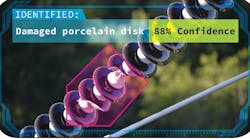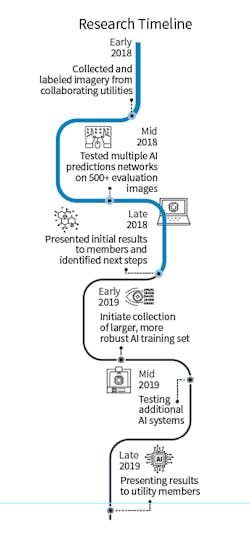Industry Challenge
Electric utilities are under pressure to reduce costs while maintaining the reliability of their aging transmission and distribution (T&D) assets. To address these challenges, utilities are looking to new and automated T&D inspection technologies such as unmanned aircraft systems (UAS), high-resolution photography, and infrared imagery. As these technologies become more autonomous, they will produce vast amounts of imagery that utilities will need to analyze. This needs to be done quickly, effectively, and at a low cost.
Using artificial intelligence (AI) to analyze visual data, such as images, is one potential solution. AI could autonomously analyze an image, determine what assets are in the image, and assess whether there are any conditions of concern.
EPRI’s Response
EPRI’s approach is to facilitate the AI community to develop solutions rather than developing a proprietary AI solution. To do this, EPRI is collecting and classifying thousands of T&D asset images and sharing them with a utility-focused AI community to enable the development of practical AI systems. Training AI systems requires thousands of images where T&D components are identified, and any high-risk conditions are labeled.
EPRI has developed a training set, a blind dataset, and a process for evaluating the performance of different AI systems. This process compares AI performance with traditional human inspections and allows utilities to build confidence in AI solutions.
Progress, Results, & Next Steps
EPRI collected and classified more than 7000 images and provided them to more than 10 vendors to train AI solutions. EPRI then used a blind dataset to evaluate performance of the systems. Specifically, the test evaluated how well they could automatically identify more than 25 T&D asset failure types.
The results to date are promising; in some cases, AI was 90% effective in finding certain conditions. While there are opportunities for improvement, the results are encouraging considering the maturity of the technology and the size of the dataset.
An additional finding is the need to build a much larger and robust dataset of well classified images. EPRI’s goal is to use advanced tools to build the utility industry’s largest dataset with the intention of providing it to the AI and T&D inspection communities for development of solutions.
How to Use the Research
If successful, EPRI could enable access to multiple AI tools, which could result in lower-cost and effective inspections for utilities. In addition, the T&D operators will understand how to incorporate AI into inspection practices, what applications perform well, how to collect AI-friendly imagery, and how to interpret the results in a meaningful way.
How to Get Involved
Collaboration is key to the success of this research. Building an effective AI T&D inspection system is a challenge that is likely too large for any single utility, but together we can make a difference. Utilities can help by supplying images to create a larger, more robust training data set. EPRI will then classify the dataset, provide it to the AI community, and evaluate performance. AI developers, T&D inspection providers, and utilities who are interested can ask for access to the dataset for training and evaluation. If you’re interested in contributing images, using the dataset, or learning more about the research, please contact Dexter Lewis, [email protected].



